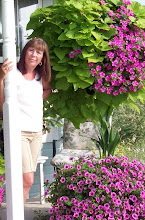 I think its almost an instinctive reflex for some folks to run right out and cut dead/dying foliage to the ground level once a hard frost has taken the life out of annuals, perennials, and ornamental grasses. Why? When I pose that question, the answer I get back most often is: Because now it just looks messy! I suppose that's all in how you perceive it. I can see how someone looking at the dried foliage in the picture to the left could view it as disorder. Some of the thick blades of the strawberries 'n cream perennial grass have broken under the weight of ice and snow and have fallen over. The seed stalks constantly tussle the winter wind. But I kinda like the brushy, unkept appearance---the winter coat, so to speak.
I think its almost an instinctive reflex for some folks to run right out and cut dead/dying foliage to the ground level once a hard frost has taken the life out of annuals, perennials, and ornamental grasses. Why? When I pose that question, the answer I get back most often is: Because now it just looks messy! I suppose that's all in how you perceive it. I can see how someone looking at the dried foliage in the picture to the left could view it as disorder. Some of the thick blades of the strawberries 'n cream perennial grass have broken under the weight of ice and snow and have fallen over. The seed stalks constantly tussle the winter wind. But I kinda like the brushy, unkept appearance---the winter coat, so to speak.The winter coat is a provider, feeding birds and other small animals. In late winter when the yellow finch begins to migrate north, they stop and feast on the black buttons of rudbeckia seed. The dried stems and stalks become a habitat in which small animals can seek shelter and where cocoons attached to the dried foliage slumber spring's butterflies.
The winter coat is a regenerator. There are some perennials that must reseed themselves in order to propagate. Violas, for example, reproduce in this fashion and who wouldn't want to leave the dry stalks in return for all those dainty, smiling faces to proliferate a garden bed in the spring? Several varieties of the lychnis family reproduce in this manner as well.
The winter coat is also an identifier. I don't accidentally dig into a clump of roots during early spring planting if I've left the dry foliage of a perennial in tact. Yesterday, we were having a bit of spring like weather. The temps rose into the upper 60's. Lu and I were out scouting around the beds in the back yard and I noticed that among the dried branches of perennials, weeds were beginning to sprout. I think its easier to identify the weeds if the dried foliage is left in tact. We immediately irradicated the offenders.
The final reason I like to leave the winter coat in tact is for protection. I've found that the dried foliage can act like a barrier for tender green foliage in a late spring frost.
Of course, there are always exceptions.
 Bluebeard caryopteris is one of those marginal perennials (living in zone 5 with extra care but preferring the climate of zone 6) that if cut back to a three inch crown and then mulched heavily, will survive our Kansas City winters. Another exception I make is for my ornamental tree, Hakuro Nishiki Variegated Willow. It is actually a shrub grafted to a standard. In order to protect the junction of the graft, I like to cut this tree back to a nice uniform sized ball of branches. The ice can collect on these shorter branches without much worry about the breakage suffered on longer branches coated in ice and whipped by a winter wind.
Bluebeard caryopteris is one of those marginal perennials (living in zone 5 with extra care but preferring the climate of zone 6) that if cut back to a three inch crown and then mulched heavily, will survive our Kansas City winters. Another exception I make is for my ornamental tree, Hakuro Nishiki Variegated Willow. It is actually a shrub grafted to a standard. In order to protect the junction of the graft, I like to cut this tree back to a nice uniform sized ball of branches. The ice can collect on these shorter branches without much worry about the breakage suffered on longer branches coated in ice and whipped by a winter wind.Typically though, most perennials, shrubs, and trees require no late fall shearing. Even the most sturdiest appreciate enduring the coldest season in their winter coat.





